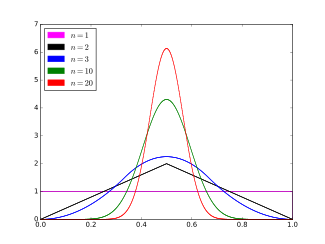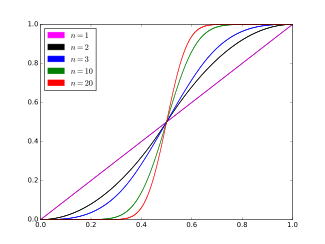| This article includes a list of general references, but it lacks sufficient corresponding inline citations. Please help to improve this article by introducing more precise citations. (June 2011) (Learn how and when to remove this message) |
Probability density function | |||
Cumulative distribution function | |||
| Parameters |
integer | ||
|---|---|---|---|
| Support | |||
| see below | |||
| Mean | |||
| Variance | |||
| Skewness | 0 | ||
| Excess kurtosis | |||
| CF | |||
In probability and business statistics, the Bates distribution, named after Grace Bates, is a probability distribution of the mean of a number of statistically independent uniformly distributed random variables on the unit interval. This distribution is related to the uniform, the triangular, and the normal Gaussian distribution, and has applications in broadcast engineering for signal enhancement.
The Bates distribution is sometimes confused with the Irwin–Hall distribution, which is the distribution of the sum (not the mean) of n independent random variables uniformly distributed from 0 to 1. If X has a Bates distribution on the unit interval, then n X has an Irwin-Hall distribution; when n = 1 they are both uniformly distributed.
Definition
The Bates distribution is the continuous probability distribution of the mean, X, of n independent, uniformly distributed, random variables on the unit interval, Uk:
The equation defining the probability density function of a Bates distribution random variable X is
for x in the interval (0,1), and zero elsewhere. Here sgn(nx − k) denotes the sign function:
More generally, the mean of n independent uniformly distributed random variables on the interval
would have the probability density function (PDF) of
Extensions and Applications
| This section needs expansion. You can help by adding to it. (February 2020) |
With a few modifications, the Bates distribution encompasses the uniform, the triangular, and, taking the limit as n goes to infinity, also the normal Gaussian distribution.
Replacing the term when calculating the mean, X, with will create a similar distribution with a constant variance, such as unity. Then, by subtracting the mean, the resulting mean of the distribution will be set at zero. Thus the parameter n would become a purely shape-adjusting parameter. By also allowing n to be a non-integer, a highly flexible distribution can be created, for example, U(0,1) + 0.5U(0,1) gives a trapezoidal distribution.
The Student-t distribution provides a natural extension of the normal Gaussian distribution for modeling of long tail data. A Bates distribution that has been generalized as previously stated fulfills the same purpose for short tail data.
The Bates distribution has an application to beamforming and pattern synthesis in the field of electrical engineering. The distribution was found to increase the beamwidth of the main lobe, representing an increase in the signal of the radiation pattern in a single direction, while simultaneously reducing the usually undesirable sidelobe levels.
See also
- Irwin–Hall distribution
- Normal distribution
- Central limit theorem
- Uniform distribution (continuous)
- Triangular distribution
References
- Jonhson, N. L.; Kotz, S.; Balakrishnan (1995) Continuous Univariate Distributions, Volume 2, 2nd Edition, Wiley ISBN 0-471-58494-0(Section 26.9)
- "The thing named "Irwin-Hall distribution" in d3.random is actually a Bates distribution · Issue #1647 · d3/d3". GitHub. Archived from the original on December 12, 2020. Retrieved 2018-04-17.
- "Sidelobe behavior and bandwidth characteristics of distributed antenna arrays". January 2018. pp. 1–2.
- "Encyclopedia of Physical Science and Technology". ScienceDirect. Retrieved 2021-12-16.
Further reading
- Bates, G.E. (1955) "Joint distributions of time intervals for the occurrence of successive accidents in a generalized Polya urn scheme", Annals of Mathematical Statistics, 26, 705–720

 integer
integer









 when calculating the mean, X, with
when calculating the mean, X, with  will create a similar distribution with a constant variance, such as unity. Then, by subtracting the mean, the resulting mean of the distribution will be set at zero. Thus the parameter n would become a purely
will create a similar distribution with a constant variance, such as unity. Then, by subtracting the mean, the resulting mean of the distribution will be set at zero. Thus the parameter n would become a purely